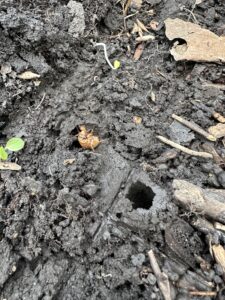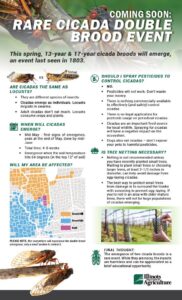May 3, 2024
Cicada sightings have begun! With soil temperatures reaching 64 degrees 8 inches below the surface, the prime soil temperature for cicadas to start their journey out of the ground, we will soon start seeing these creatures take over the landscape for the next month. Just the other day we were walking in the woods and when we lifted up a log we saw our first cicada of the season, along with some other emergence holes.
We’ve gotten lots of questions about cicadas and what this means for trees, so we’ve compiled a list of some great resources for further reading. We put together a blog post with some basic information and so did the iTrees team, but we’ve come across some more resources and articles that we wanted to share!
SGN Blog Post: Brooding Thoughts 2-23-24
For a refresher, we will soon start seeing millions of 13 and 17 year cicadas emerging from the ground to feast, mate, lay eggs, and then die. Their time above ground is short, only a few weeks, and they are harmless. If you haven’t heard about this phenomenon yet, you definitely will soon because the male cicadas will start singing their extremely loud mating song shortly!
One of the biggest questions we’ve gotten from folks is, “Are my trees going to be okay?” Our answer is similar to any other time of year: most likely, yes! We obviously cannot guarantee that trees will go unscathed, similar to any other natural event like a storm, late frost, drought, or heatwave, but there is solid evidence out there that can give you peace of mind. According to ILCA resources,
“Female cicadas lay eggs in trees and prefer twigs about the size of a pencil. The female makes a small slit in the branch to deposit her eggs. These cause small wounds that will not impact the overall health of most trees. Very small trees, like the whips you see planted on Arbor Day, are most at risk from damage caused by egg laying by female cicadas. Plants installed by landscape crews are generally large enough to survive these small cuts. Small trees can be wrapped in tulle or netting to play it safe. Larger trees are resilient and don’t require any help from you or your landscape crews. Well-maintained trees are watered regularly, mulched properly, and checked routinely for pests and diseases.”
 Any issues that may arise with trees would be in small branches in very young trees. The “damage” to twigs is considered a natural pruning, and should not harm the life of the tree. You may notice that affected branches fall off due to the stress of the cicada laying eggs, but there are also ways to protect your tree if you are worried! From The Morton Arboretum:
Any issues that may arise with trees would be in small branches in very young trees. The “damage” to twigs is considered a natural pruning, and should not harm the life of the tree. You may notice that affected branches fall off due to the stress of the cicada laying eggs, but there are also ways to protect your tree if you are worried! From The Morton Arboretum:
“While the insects can’t harm people, pets, plants, and healthy mature trees, there is some risk of damage to young and other vulnerable trees and shrubs. After the cicadas pair up through those ear-splitting mating calls, the females make small slits in slender twigs and lay their eggs there. This is not a problem for trees that are mature, with big branches and plenty of twigs to spare. However, small or newly planted trees, whose branches are mostly twig-sized, are at more risk of lasting damage.
The best way to protect these young trees is to wrap their branches in fine-mesh netting before early May. Commercial insect netting can be purchased online or from some garden centers and landscape suppliers. Tulle—the nylon or polyester mesh used to make ballerina tutus, sold in fabric and some hobby stores—works well.”
Both The Morton Arboretum and Chicago Botanic Garden have a lot of great info, and excellent videos on those linked pages about how to wrap up a small tree. We recommend those videos for a step-by-step guide to making sure your young tree is protected. The Morton Arboretum says, “The netting needs to have a fine enough mesh to keep out cicadas, with holes ¼ inch wide or less. The fabric must also be strong enough to last for several weeks on the tree. Don’t use netting with holes ½ inch wide or more; that won’t stop a cicada.”
“Wrap the entire branching area of the tree. It will likely take at least several yards of fabric. Where sheets of fabric meet, overlap the edges, tuck them under once or twice, and secure the roll with binder clips, clothespins, or staples. Below the branches, gather the netting around the trunk or the base of the shrub and clip it, staple it or tie it with twine. Make sure there is no gap more than ¼ inch. Do not tie anything around the trunk so tightly that it damages the bark.
Netting must stay on the tree for about six weeks, beginning in late April or early May. Be sure to remove the netting and any string or rope tied around the trunk once the cicadas have died.
Wait until the cicadas have subsided to prune out any visible damage. It is often not necessary; dead twigs will likely fall off a tree, and larger branches are not affected. Studies have shown that most wounds left in twigs by cicadas callus over with new wood in one to two years.”
According to the ILCA resources, “Cicada eggs will hatch 6 to 10 weeks after they are laid. The tiny cicada nymphs will drop from tree branches to the ground and begin feeding on grass roots without causing damage. Over time, the nymphs will dig 8-12 inches into the soil, and feed on tree roots for the next 13 or 17 years.”
This is a natural phenomenon that only occurs every 221 years! And remember, DON’T SPRAY insecticides to try and get rid of the cicadas. That will do more harm to the ecosystem than good!
If you have any questions don’t hesitate to ask us, and if we don’t know the answer we will do our best to point you in the right direction! We are lucky to have such great resources not far from us like The Morton Arboretum, Chicago Botanic Garden, and the University of Illinois Extension to learn more about these unique creatures. We’ll leave you with this hilarious, and educational, video from our friends at the DuPage County Forest Preserve! Enjoy!
~ Maggie Thomas Harper






Leave a Reply